| 5 May |
• yesterday • tomorrow |

• Aurelius Augustinus
• Doctor of Grace
28 August (feast)
Son of a pagan father who converted on his death bed, and of Saint Monica, a devout Christian. Raised a Christian, he lost his faith in youth and led a wild life. Lived with a Carthaginian woman from the age of 15 through 30. Fathered a son whom he named Adeotadus, which means the gift of God. Taught rhetoric at Carthage and Milan, Italy. After investigating and experimenting with several philosophies, he became a Manichaean for several years; it taught of a great struggle between good and evil, and featured a lax moral code. A summation of his thinking at the time comes from his Confessions: "God, give me chastity and continence - but not just now."
Augustine finally broke with the Manichaeans and was converted by the prayers of his mother and the help of Saint Ambrose of Milan, who baptized him. On the death of his mother he returned to Africa, sold his property, gave the proceeds to the poor, and founded a monastery. Monk. Priest. Preacher. Bishop of Hippo in 396. Founded religious communities. Fought Manichaeism, Donatism, Pelagianism and other heresies. Oversaw his church and his see during the fall of the Roman Empire to the Vandals. Doctor of the Church. His later thinking can also be summed up in a line from his writings: Our hearts were made for You, O Lord, and they are restless until they rest in you.
13 November 354 at Tagaste, Numidia, North Africa (Souk-Ahras, Algeria) as Aurelius Augustinus
28 August 430 at Hippo, North Africa
• against sore eyes
• against vermin
• brewers
• printers
• theologians
• 7 dioceses
• 7 cities
• child
• dove
• eagle
• pen
• shell
• flaming heart, an allusion to a passage in his Confessions
Conquer yourself and the world lies at your feet. - Saint Augustine
God has no need of your money, but the poor have. You give it to the poor, and God receives it. - Saint Augustine
The honors of this world, what are they but puff, and emptiness and peril of falling? - Saint Augustine
Daily advance, then, in this love, both by praying and by well doing, that through the help of Him who enjoined it on you, and whose gift it is, it may be nourished and increased, until, being perfected, it render you perfect. - Saint Augustine
What do you possess if you possess not God? - Saint Augustine
Unhappy is the soul enslaved by the love of anything that is mortal. - Saint Augustine
The love of worldly possessions is a sort of bird line, which entangles the soul, and prevents it flying to God. - Saint Augustine
This very moment I may, if I desire, become the friend of God. - Saint Augustine
God bestows more consideration on the purity of the intention with which our actions are performed than on the actions themselves. - Saint Augustine
I will suggest a means whereby you can praise God all day long, if you wish. Whatever you do, do it well, and you have praised God. - Saint Augustine
This is the business of our life. By labor and prayer to advance in the grace of God, till we come to that height of perfection in which, with clean hearts, we may behold God. - Saint Augustine
God in his omnipotence could not give more, in His wisdom He knew not how to give more, in His riches He had not more to give, than the Eucharist. - Saint Augustine
God does not command impossibilities, but by commanding admonishes you do what you can and to pray for what you cannot, and aids you that you may be able. - Saint Augustine
Our life and our death are with our neighbor. - Saint Augustine
https://catholicsaints.info/saint-augustine-of-hippo/
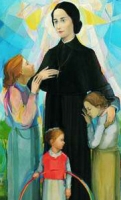
Katarina Cittadini
Daughter of Giovanni Battista and Magherita Lanzani. Her mother died when Caterina was seven, and her father abandoned the girl and her younger sister Giuditta. They were accepted and grew up at the orphanage of the Conventino of Bergamo. There she developed a strong faith, a big sister's sense of responsibility, and a devotion to Our Lady and Saint Jerome Emiliani.
The sisters left the orphanage in 1823 to live with their cousins Giovanni and Antonio Cittadini, both parish priests at Calolzio, Italy. Caterina became a teacher at a girl's public school in Somasca in 1824. The sisters felt a call to the religious life; their spiritual director recommended that they should stay in Somasca, and become the basis of a new congregation.
In 1826 the sisters rented a house in Somasca, bought and furnished a building, and in October opened a boarding school for girls. Caterina taught religion, managed the school, and instituted the oratory style of education for her girls. Word of her success spread, attracting more students. The sisters established another "Cittadini" private school in 1832, and another in 1836.
Giuditta directed these new school until her sudden death in 1840. Caterini's cousin, Father Antonio Cittadini, died in 1841, followed quickly by her spiritual director from the orphanage. The rapid succession of tragedy ruined Caterina's health, and she fell gravely ill, but was cured through the intercession of Saint Jerome Emilani.
Caterina quit her public teaching position in 1845 to manage the schools, care for the orphans, and guide the three companions who help her. To help organize the work and lives of her companions, she wrote the beginnings of a new rule similar to that of religious orders. In 1850 she obtained permission to build a private oratory to keep the Blessed Sacrament at her boarding school. In 1851 she applied for approval of her new religious family.
In 1854 her bishop encouraged her work, and told her to write the rules of the new order; her first attempt, based on the Constitution of the Ursulines of Milano was rejected. A second attempt was accepted on 17 September 1854 under the title Orsoline Gerolimiane (Ursuline Sisters of Somasca). On 14 December 1857, six months after her death, the bishop of Bergamo gave his approval; the order achieved papal recognition on 8 July 1927. The order's mandate is to teach, and to care for the abandoned; today they work in Italy, Switzerland, Belgium, Brazil, Bolivia, India, and the Philippines.
28 September 1801 in Bergamo, Italy
5 May 1857 in Somasca, Bergamo, Italy of natural causes
29 April 2001 by Pope John Paul II at Saint Peter's Square, Vatican City
Left an orphan at a very tender age, she became an affectionate mother to orphans. She wanted her spiritual daughters to be 'mothers' in schools and in contacts with children. The secret was union with the Eucharist. ? Pope John Paul II
https://catholicsaints.info/blessed-caterina-cittadini/
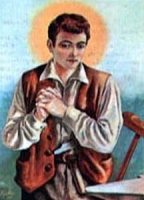
• Nunzio Sulperio
• Nunzio Sulprizio
Son of Domenico Sulprizio and Rosa Luciani, Nunzio was named after his grandfather and baptized when only a few hours old. Nunzio’s father died on 16 May 1820 when the boy was only three years old, his little sister died in 1822, and his new step-father treated the boy as a contemptible burden. Young Nunzio received his basic education at a school run by a priest, and became a pious child, attending Mass as often as possible, and using the saints as a guide to life. When he was old enough, his uncle Domenico Luciani took Nunzio as an apprentice blacksmith, and then neglected him, abused him, overworked him, beat him, and after bringing home supplies on a winter morning in 1831, the boy collapsed with a fever and found he could no longer stand; an untreated injury to his leg had become gangrenous. He was hospitalized in L’Aquila and Naples in Italy; when he was at home, and could find a place where people would not run him off due to his open sores, he would sit in a stream to let the flowing water clean his wound, and pray his rosary. Through his paternal uncle, Francesco Sulprizio, a career soldier, Nunzio became friends with Colonel Felice Wochinger in 1832; the colonel became a surrogate father and paid for Nunzio’s medical care. The boy met and impressed Saint Gaetano Errico, who said he would be welcome in the Missionaries of the Sacred Hearts of Jesus and Mary when he was old enough. Nunzio went through several periods of improvement and several of setbacks before his injuries finally ended his life. He was known as a gentle, chaste, patient, and pious youth in a place and time when such a man was rare.
13 April 1817 at Pescosansonesco, Pescara, Abruzzi, Italy
• 5 May 1836 in Naples, Italy
• interred at the church of San Domenico Soriano in Naples
• 14 October 2018 by Pope Francis at Saint Peter's Square, Rome, Italy
• the canonization miracle involved the healing of a young man who had been injured in a motorcycle accident and went into a coma which was expected to leave him in a vegetative state; a relic of Blessed Nuntius was placed in the patient’s room, and after a week of prayers by family, he woke from the coma
workers (proposed by Pope Leo XIII)
https://catholicsaints.info/blessed-nuntius-sulprizio/
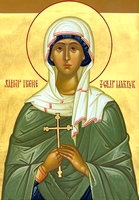
Erina, Eiréne
The daughter of a wealthy, pagan named Licinius, her father considered Irene so beautiful and such a desirable marriage that he kept her locked in a tower with 13 guards. She received instruction in Christianity directly from God, was baptized by Saint Timothy, and when her father brought idols to the tower for her to worship, Irene would smash them. To punish her refusal of paganism, Licinius tied Irene behind a horse so it would drag her to death; she was miraculously unharmed, and the horse bit Licinius, giving him an injury that festered and killed him. However, Irene prayed for her father who was then brought back to life. Licinius converted, the father and daughter teamed up as evangelists and converted thousands of pagans. This angered the anti–Christian governor Ampelio who captured, imprisoned and tortured Irene, and ordered her to renounce her faith; she refused. Martyr.
Details of time and place are absent in the earliest version of her story, but later retellings add them, change them, move her from place to place, increase the number of pagans converted, link her to many, many miracle stories, and eventually place her martyrdom in Persia just as Contantine the Great is born.
beheaded
• Pre-Congregation
• there have been churches dedicated to her in Constantinople since the 5th century
Altamura, Italy
https://catholicsaints.info/saint-irene-of-lecce/

• Angelus of Sicily
• Angelus the Carmelite
• Angelo of...
Angelus' parents were 12th century Jewish converts. At age 18, Angelus and his twin brother joined a group of hermits who formed the first Carmelite house. He was sent to evangelize in Sicily, met with great success in converting some Sicilian Jews, and great hatred from others, especially around Palermo and Leocata. Murdered by thugs in the employ of Count Berengarius, a man whose incestuous relationship Angelus had denounced.
1145 at Jerusalem
• stabbed to death in 1220 at Licata, Sicily, Italy
• relics transferred in to the Carmelite church at Licata
Licata, Italy
• Carmelite with a knife in his head
• Carmelite with a sword in his breast, holding a book, palm, and three crowns
• Carmelite with an angel bringing him three crowns
• Carmelite with lilies and roses falling from his mouth, indicative of his eloquence
• lily
https://catholicsaints.info/saint-angelus-of-jerusalem/
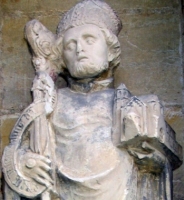
• Godehard the Bishop
• Godard, Gothard, Gottardo, Gotthard, Godehardus
2nd Sunday in May (Bene Vagienna, Italy)
Raised around Churchman, Godehard's father worked for the canons of Niederaltaich. Godehard joined the canons, and became their provost. Helped reintroduce the Benedictine Rule at Niederaltaich, which then sent abbots to Tegernsee, Hersfeld and Kremsmunster to revive the Benedictine Rule. Bishop of Hildesheim, Germany in 1022.
c.960 in Bavaria (in modern Germany)
• 4 May 1038 of natural causes
• relics translated in 1132
1131 by Pope Innocent II
• against birth pains
• against childhood sicknesses
• against danger at sea
• against dropsy
• against fever
• against gout
• against hailstorms
• travelling merchants
• Bene Vagienna, Italy
• diocese of Hildesheim, Germany
• dragon
• holding a church
https://catholicsaints.info/saint-godehard-of-hildesheim/
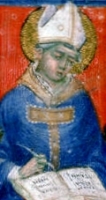
• Hilarius
• Ilario
Born and raised a pagan; relative of Saint Honoratus of Arles. Highly placed civil authority. Honoratus invited Hilary to the recently completed abbey of Lerins, and brought him to the faith; Hilary was baptised at Lerins, and joined the community as a monk. When Honoratus became bishop of Arles (in modern France) Hilary served as his secretary. Bishop of Arles. Hilary was an exuberant bishop, working so hard to spread the faith that he caused problems with the people and the civil authorities, and twice had to be reproved by the Vatican - his zealousness was causing more trouble than converts. But though some questioned his methods, none questions his sanctity or his true belief.
c.400 at Lorraine, France
449 of natural causes
https://catholicsaints.info/saint-hilary-of-arles/
• Benventuto of Recanati
• Benevenutus, Benvenutus
13th-century Franciscan Conventual lay brother in Recanati, Italy. Worked at his monastery as a cook, and spent his free time in prayer. During prayer and Mass he would lapse into ecstacies and receive visions; during one vision he was allowed to hold the Infant Christ. Legend says that once when a trance lasted so long that he was late to his work in the kitchen, he found an angel there already cooking.
Recanati, Italy
• 5 May 1269 in Recanati, Italy of natural causes
• interred at the church of San Franceso in Recanati
17 September 1796 by Pope Pius VI (cultus confirmation)
https://catholicsaints.info/blessed-benvenuto-mareni/

• Judith of Kulmsee
• Judith of Sangerhausen
• Judith of Thuringia
• Jutta, Giuditta
Born to the nobility. Lay woman. Married with children. Widowed when her husband died on a Crusade to the Holy Land. Judith then made financial provision for her children, sold off her property, and spent her remaining years as a hermitess in the territory of the Teutonic Knights, whose grand-master was a relative.
at Sangerhausen, Thuringia (in modern Germany)
12 May 1260 at Kulmsee, Prussia (in modern Germany) of natural causes
Prussia
https://catholicsaints.info/saint-judith-of-prussia/

• Avertinus the Deacon
• Avertin, Avertino
Deacon who travelled into exile in France with Saint Thomas Becket. Participated in the synod of Tours, France in 1163. After the death of Saint Thomas, Avertinus dedicated himself to the service of the poor and strangers at Vinzai, Touraine, France, and spent his final years as a hermit.
• 1189 at Vençay, France of natural causes
• buried at the church in Vençay which became a site of miracles and pilgrimage
https://catholicsaints.info/saint-avertinus-of-tours/
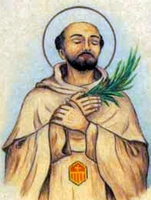
Born to the Savoian nobility in the area of the modern border of France and Italy, Lucio joined the Mercedarians at the convent in Carcassone, France. Assigned to redeem Christians enslaved by Muslims in north Africa, he was captured at sea by Moorish pirates. Lucio spent the next 16 years imprisoned in Tunis and in Egypt, repeatedly tortured and being ordered to renouce his faith; he refused. Martyred by order of Sultan Bajazet II.
beheaded on 5 May 1470 in Constantinople (modern Istanbul, Turkey)
https://catholicsaints.info/blessed-lucio-of-savoy/
Brito, Britonius, Brittone
Bishop of Trier, Belgic Gaul (modern Germany) in 374, and a leader of the Church in Gaul. Attended the 382 synod of bishops called by Pope Saint Damasus I. Friend of co-worker with Saint Ambrose of Milan and Saint Martin of Tours. When a group of pagans sought sanctuary with the Church; Britto tried to convert them, failed, but still refused to surrender them since he believed that the State has no authority over Church affairs.
4th century
c.385 in Trier, Germany
https://catholicsaints.info/saint-britto-of-trier/
• Boleslaw Frackowiak
• Gregory Frackowiak
• Gregorio Frackowiak
12 June as one of the 108 Martyrs of World War II
Friar in the Society of the Divine Word. Martyred by Nazis.
18 July 1911 in Lowecice, Wielkopolskie, Poland
guillotined on 5 May 1943 in Dresden, Saxony, Germany
13 June 1999 by Pope John Paul II
https://catholicsaints.info/blessed-grzegorz-boleslaw-frackowiak/
Tusca
Sister of Bishop Procolo. Hermitess in Verona, Italy who was known for her piety, and was often visited by area lay people in search of spiritual wisdom. When Saint Teuteria fled England, Tosca took her in.
Verona, Italy
relics enshrined on 14 September 1161 in the basilica of Verona, Italy by bishop Ognibene
• Pre-Congregation
• a church dedicated to is known to have existed in Verona in 750
https://catholicsaints.info/saint-tosca-of-verona/
Maurand, Mauront, Maurontus, Mauronto
Eldest son of Saint Adalbald of Ostrevant and Saint Rictrudis of Marchiennes; brother of Saint Clotsindis of Marchiennes, Saint Eusebia of Hamage, and Saint Adalsindis. Monk at Marchiennes, France. Founded a monastery at Breuil-sur-lys near Douai, France.
634
702 in Marchiennes, France of natural causes
Douai, France
https://catholicsaints.info/saint-maurontius-of-douai/
Adult convert to Christianty. To escape the attentions of pagan king Oswald, she fled to Italy where she hid with Saint Tosca, and became her spiritual student. Hermitess.
7th–8th century England
relics enshrined on 14 September 1161 in the basilica of Verona, Italy by bishop Ognibene
• Pre-Congregation
• a church dedicated to is known to have existed in Verona in 750
https://catholicsaints.info/saint-teuteria-of-verona/
For publicly declaring his Christianity, Maximus was branded on the foot, blinded in one eye, and sentenced to forced labour in the mines during the persecutions of Maximian Galerius. He was crippled, but survived and was released during the reign of Constantine. Bishop of Jerusalem.
c.350 in Jerusalem of natural causes
https://catholicsaints.info/saint-maximus-of-jerusalem/
Priest in Edessa, Syria. When a Arian bishop was imposed on the area by Emperor Valens, Eulogius refused to renouce orthodox Christianity and was exiled to Thebaid, Egypt where he worked for the conversion of local pagans. When Valens died in 375 Eulogius returned to Edessa to serve as their bishop. Attended the Council of Constantinople in 381.
https://catholicsaints.info/saint-eulogius-of-edessa/
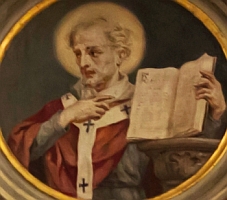
Gerontius
Bishop of Milan, Italy c.465 to c.470.
• c.470
• relics enshrined in the church of Saint Symphorian in Milan, Italy by Saint Charles Borromeo
https://catholicsaints.info/saint-geruntius-of-milan/
John Hale
Priest. Fellow of King's Hall, Cambridge. Vicar of Isleworth, Middlesex, England. Martyred with Saint John Houghton and three others.
hanged on 4 May 1535 at Tyburn, London, England
29 December 1886 by Pope Leo XIII (cultus confirmation)
https://catholicsaints.info/blessed-john-haile/
• Sacerdos of Calviac
• Sardot, Sadroc, Sardou, Serdon, Serdot, Sacerdote
Monk. Founded Calabre Abbey and served as its first abbot. Bishop of Limoges, France.
670 in Sarlat, Périgord, France
c.720
https://catholicsaints.info/saint-sacerdos-of-limoges/
Twelfth century hermit in Calabria, Italy who divided his time between contemplation of God and good works for the poor. Founded a monastery in Africo, Reggio, Italy, and lived out his later years there.
Africo, Italy
Africo Nuovo, Italy
https://catholicsaints.info/saint-leo-of-africo/
Gioviniano, Giovine
Missionary. Lector of the church at Auxerre, France. Worked with Saint Peregrinus of Auxerre. Martyr.
martyred c.300
https://catholicsaints.info/saint-jovinian-of-auxerre/
Martyred in the persecution of Diocletian
burned at the stake c.303 at Thessalonica
https://catholicsaints.info/saint-peregrinus-of-thessalonica/
Bishop of Saguntum (now Murviedro), Spain.
c.560 of natural causes
Saguntum, Spain
https://catholicsaints.info/saint-sacerdos-of-saguntum/
Martyred in the persecution of Diocletian.
burned at the stake c.303 at Thessalonica
https://catholicsaints.info/saint-irenaeus-of-thessalonica/
Martyred in the persecution of Diocletian.
burned at the stake c.303 at Thessalonica
https://catholicsaints.info/saint-irenes-of-thessalonica/
Deacon in Alexandria, Egypt. Imprisoned for his faith, he eventually died of mistreatment. Martyr.
https://catholicsaints.info/saint-euthymius-of-alexandria/
Etha of Crayke
Priest. Lived as a hermit in Crayke, Yorkshire, England.
767
https://catholicsaints.info/saint-echa-of-crayke/
Bishop of Vienne, France. Supported the expansion of monastic life in his diocese.
c.449
https://catholicsaints.info/saint-nicetus-of-vienne/
First Abbess of Saint-Pierre-aux-Nonnais Abbey in Metz, France.
c.620
https://catholicsaints.info/saint-waldrada-of-metz/
Sylvanus
Martyr.
in Rome, Italy
https://catholicsaints.info/saint-silvanus-of-rome/
Bishop of Bologna, Italy for 20 years.
c.550
https://catholicsaints.info/saint-theodore-of-bologna/
Hydoc
Lived in the 5th century.
Lanhydroc, Cornwall, England
https://catholicsaints.info/saint-hydroc/
Martyr.
5th century Rome, Italy
https://catholicsaints.info/saint-crescentiana/
• Our Lady of Adoration
• Our Lady of Europe
• Faelan Finn of Kilcolumb
• Lanno of Vasanello
• Martino of Finojosa
• Prisca of San Sperate
CatholicSaints.Info Portable Edition